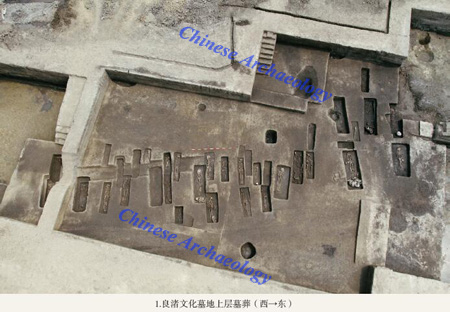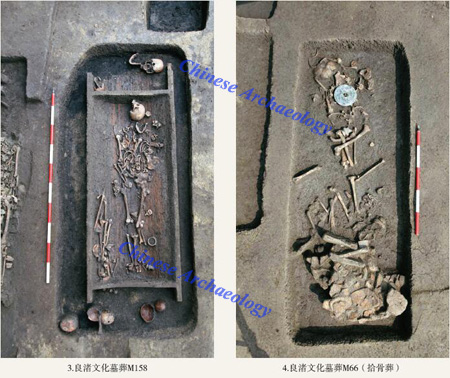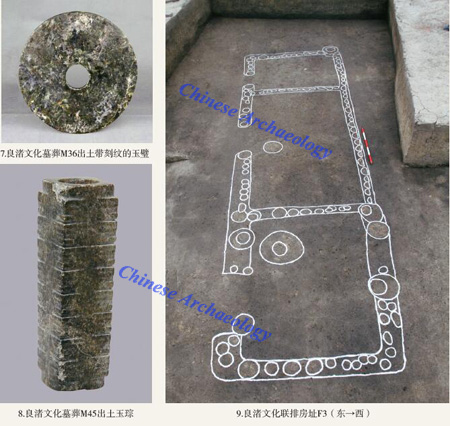New Discovery of Liangzhu Culture Found in Jiangzhuang Site, Jiangsu Province
From:Chinese Archaeology NetWriter:Date:2016-01-19
Jiangzhuang Site is located at the junction of Xinghua and Dongtai county, Jiangsu province. The site was divided into the eastern and the western area. The eastern zone (Zone II) was mainly the accumulation of the Tang and Song dynasties, with an area of 450,000 square meters. While, the western zone (Zone I) was mainly the accumulation of Liangzhu culture site in the Neolithic Age, with an area of nearly 20,000 square meters. The site was densely covered with rivers. From October in 2011 to November in 2015, Nanjing Museum conducted a salvage excavation to the site. The excavation was focus on the western zone, with a total area of 3500 square meters, unearthing a Liangzhu cultural settlement, including 278 tombs, 8 house foundations, more than 110 ash pits, in addition to wells, ash ditches, and nearly 1200 pieces of jade, stone, pottery, bone objects.
Upper burial in Liangzhu Cultural Cemetery of Jiangzhuang Site
Liangzhu cultural cemetery is the most important element of the Liangzhu cultural settlement of Jiangzhuang Site. The cemetery was located at the northeastern of the settlement, and was in the north and south trend. The distribution of tombs was very dense, and the overlying and breaking relationship was complicated. One group of breaking relationship involved 80 tombs. The density and layer relation indicated this area was used for public cemetery, and had lasted for a long time. In addition, the tombs of high class and common people were laid separately, those of the high class were located at the south, while those of common people at the middle and north.

Liangzhu Cultural tomb M111

Liangzhu Cultural tomb M158 M66
The shape and structure of the tombs was all rectangular shaft pit, and the types were various, including secondary burial. The burials were single extended supine position burial, heading to the east, and were mainly distributed at the middle and north part of the cemetery. While secondary burials were divided into cremation and Shigu burial (a burial custom that reopening the tomb to pick up bones to rebury after buried for several years), and the high class tombs with jade Cong tube and jade Bi disk were all secondary burials. Among them, cremation tombs were mainly distributed at the middle and east, and the burial pits were small, with few funerary objects and small scale pottery, and the skeleton appeared white and chunky. So far, archaeologists cleared up 34 cremation tombs, making up 24.3% of the total. Except the skeletons of the cremation tombs, those of all the rest were better preserved. Nearly all the tombs were headed towards the east, a few secondary burials were in north and south trend, and only few were headed towards the west. Funerary implements were commonly used. Recognizable coffins were all made of a complete timber with arch bottom, and the cover shaped flat or arch.

Liangzhu Cultural tomb M116
In total, more than 700 pieces of cultural relics were found. Jade items included Cong tube, Bi disk, cone-shaped object, bracelet, ring, tube, bead, pendants and so on. Stone ware included axe, Bi disk, adz, chisel, knife, spinning wheel and so on. Pottery included Ding tripod, double-nose pot, jar, Dou steamer, bowl, ring-foot plate, Gui vessel (tripod), wide mouth Zun vessel, pot with ears on side, object lid, spinning wheel and so on. Wooden-body lacquer ware was commonly seen, but only red trace was left, most of which were Gu vessel. Stone axe, adz, chisel and pottery spinning wheel could not exist at the same time. The former occupant was a male, but the latter was a female, indicating the difference between gender and social division of labor.
The layout of the Liangzhu cultural settlement was preliminarily revealed. Water system around the settlement was well developed, and ditch outside the settlement was connected to Taidong River, and went directly to the Yangtze River. 8 house foundations of Liangzhu cultural period were all buildings on the ground with pillar base, and the shape was circular or rectangular. The multi-room and rows house are common characteristics. Wells and ash pits were mostly located in the residential area.

Pottery unearthed from Liangzhu Cultural Cemetery of Jiangzhuang Site

Jadeware unearthed from Liangzhu Cultural Cemetery of Jiangzhuang Site(left)
Liangzhu Cultural house foundation of Jiangzhuang Site(right)
Liangzhu cultural cemetery, Jiangzhuang Site is one of the tombs of largest number and most densely buried. A variety of funeral forms and customs can be seen, and some skeletons and funeral implements were well preserved. It offers precious material data for understanding the burial custom, social organization and human species.
A rich number of jade and stone objects and pottery of Liangzhu culture were unearthed in Jiangzhuang Site. The black pottery pot carved with pig and character reflects the production and life, and the artistic creativity of Liangzhu ancestors. The jade Bi disk with “凸” shaped altar sign was unearthed in the definite strata relationship and co-exist tomb for the first time, has great value for studying the spiritual believes of Liangzhu ancestors. (Translator: Wang Jue)

